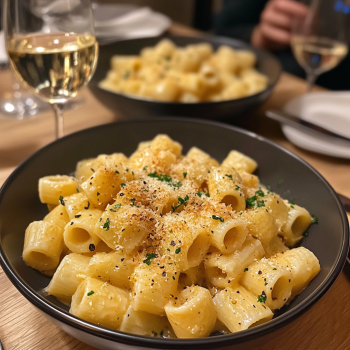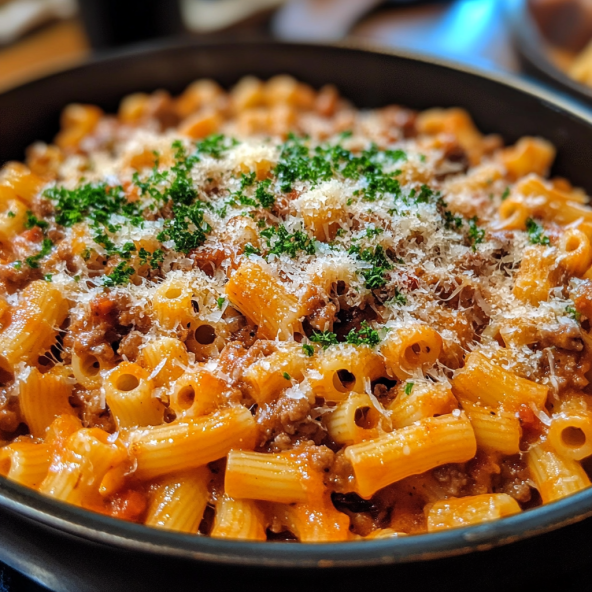What is the Difference Between Ditalini and Ditaloni?
If you’ve ever found yourself wondering, “What is the difference between ditalini and Ditaloni?”, you’re not alone. While both are Italian pasta varieties, they differ in size, texture, and typical uses. Understanding these differences will help you appreciate the unique role each pasta plays in Italian cuisine.
Both ditalini and Ditaloni share similarities in shape and family but have distinct characteristics that make them suited to different dishes. This article will explore these differences, helping you determine when and how to use each pasta in your cooking.
Table of Contents
Introduction to Italian Pasta Shapes: Understanding Ditalini and Ditaloni
The Rich History of Pasta in Italy
Pasta is a cornerstone of Italian cuisine, with each region in Italy producing its own unique shapes. From simple spaghetti to intricate stuffed pastas like tortellini, Italy boasts a rich variety of pasta that reflects its diverse culinary traditions. The origins of pasta can be traced back to ancient times, with each shape designed to hold sauces in specific ways, ensuring optimal flavor.
The Significance of Pasta Shapes in Italian Cuisine
The shape of pasta is far from arbitrary. Italians believe that the right pasta shape enhances the flavors and textures of the dish it complements. For example, long, thin noodles like spaghetti pair well with lighter sauces, while tube-shaped pastas like ditalini and Ditaloni are ideal for heartier, chunky sauces and soups.
Understanding Ditalini: What Is Ditalini Pasta?
What is Ditalini?
Ditalini are small, tube-shaped pasta pieces, approximately the size of a pinky finger. Their name comes from the Italian word “dito”, meaning “finger,” and “ini”, a diminutive suffix indicating something small. As a result, ditalini are tiny, bite-sized tubes perfect for soups, pasta salads, and baked dishes.
Common Culinary Uses of Ditalini
Ditalini is especially popular in soups, such as the classic minestrone. The small size of ditalini allows it to absorb the flavors of the soup, making each bite a balanced combination of pasta and broth. It’s also used in pasta salads and is sometimes added to baked dishes, where it absorbs rich sauces and cheeses.
How Ditalini is Made
Ditalini is traditionally made by mixing semolina flour and water, then shaping the dough into small tubes. The pasta is then dried to preserve it. This simple method ensures that the pasta remains al dente when cooked and holds its shape well in various dishes.
Exploring Ditaloni: What Is Ditaloni Pasta?
What is Ditaloni?
are similar to ditalini but are larger in size, both in length and diameter. They are also tube-shaped and often used in similar ways. The term “Ditaloni” is derived from the same root word “dito”, but their larger size allows them to be used in dishes where a more substantial pasta is needed.
Typical Dishes Using Ditaloni
It is commonly used in hearty pasta dishes such as pasta e fagioli, a traditional Italian soup made with beans and vegetables. Ditaloni’s larger size allows it to hold more sauce, making it ideal for thick and rich sauces. It can also be used in casseroles or pasta bakes, where its substantial size can support robust ingredients.
The Production Process of Ditaloni
Like ditalini, ditaloni is made using semolina flour and water. However, due to its larger size, ditaloni requires slightly more time in the drying process to achieve the right consistency. The pasta is extruded through larger molds and cut into longer tubes.
Key Differences Between Ditalini and Ditaloni
Size and Shape Comparison between ditalini and ditaloni
The most obvious difference between ditalini and ditaloni is their size. While both are tube-shaped pastas, ditalini are much smaller and shorter than ditaloni. Ditaloni are wider and longer, offering a more substantial bite. This size difference plays a key role in determining which pasta is more suitable for certain dishes.
Textural Differences for Ditalini and Ditaloni
Ditalini, due to its smaller size, tends to cook faster and has a slightly more delicate texture. In contrast, ditaloni holds a firmer texture and stands up better in thicker, chunkier dishes. The larger size of ditaloni allows it to retain its texture when cooked in rich sauces, unlike ditalini, which might soften more quickly.
Cooking Times for Ditalini and Ditaloni
Ditalini cooks faster than ditaloni, usually in around 7-9 minutes, while ditaloni may take 10-12 minutes. This difference in cooking time can affect how the pasta behaves in a dish, with ditalini better suited for soups and ditaloni ideal for heartier, more substantial dishes.
Dish Compatibility for Ditalini and Ditaloni
Ditalini is better suited for light soups, salads, and dishes where the pasta is meant to blend into the background. Ditaloni, due to its larger size, works better in heavier, more robust dishes, including thick stews, casseroles, and baked pasta dishes.
Nutritional Comparison of Ditalini vs Ditaloni: A Breakdown
Caloric Values
Both ditalini and ditaloni are made from semolina flour, so their caloric content is quite similar. A typical serving of either pasta (about 100 grams) contains around 350 calories, primarily from carbohydrates.
Macronutrients
- Carbs: Both ditalini and ditaloni are rich in carbohydrates, providing the body with quick energy.
- Protein: Ditalini and ditaloni offer a moderate amount of protein, approximately 7-8 grams per 100 grams.
- Fats: Both have very low fat content, making them suitable for a low-fat diet.
Any Special Dietary Considerations
Since both ditalini and ditaloni are made from semolina, they are not suitable for gluten-free diets. However, gluten-free versions are available, made with alternative flours such as rice flour or cornmeal.
How to Choose Between Ditalini and Ditaloni
Dish Suitability
When deciding between ditalini and ditaloni, consider the dish you’re preparing. Ditalini is ideal for lighter soups and pasta salads, while ditaloni is better suited for heartier dishes like pasta e fagioli or thick sauces.

Personal Preferences
Some people prefer the bite and texture of ditaloni due to its larger size, while others may enjoy the delicate nature of ditalini. Ultimately, the choice depends on your personal preferences and the specific needs of the recipe.
Recipes Featuring Ditalini
Ditalini in Soups, Like Minestrone
Ditalini is a staple in minestrone soup, where it absorbs the flavors of the broth and vegetables. The small size of ditalini makes it perfect for soups, as it mixes well with other ingredients without overpowering them.
Ditalini Pasta Salads
Ditalini is also a great addition to pasta salads. Its small size allows it to hold a variety of ingredients, including vegetables, olives, and cheeses. Toss it with a light vinaigrette or creamy dressing for a refreshing dish.
Creative Uses in Modern Cuisine
In modern Italian cuisine, ditalini can be used in unique ways, such as in baked pasta dishes or even stir-fries. Its versatility makes it a favorite among chefs for innovative pasta creations.
Recipes Featuring Ditaloni
Ditaloni in Baked Pasta Dishes
Ditaloni, with its larger tube shape, works wonderfully in baked pasta dishes. The pasta’s size allows it to hold up well under rich, chunky sauces and cheeses, making it an excellent choice for casseroles and baked pasta bakes. For a simple yet delicious dish, combine ditaloni with a tomato sauce, ground meat, and plenty of mozzarella cheese, then bake until golden and bubbly.
Ditaloni with Hearty Sauces
The robust size of ditaloni makes it ideal for hearty sauces like Bolognese or ragu. Its larger tubes are excellent at holding thick, meaty sauces, which makes each bite satisfyingly filled with flavor. The texture of ditaloni complements these sauces, creating a perfect harmony of ingredients.
Alternative Cooking Ideas
Ditaloni is also a great option for stir-fries and sautés. Try using it in place of other pasta varieties for a more substantial meal. Toss ditaloni with roasted vegetables, fresh herbs, and olive oil for a simple yet flavorful dish.
Cooking Tips for Both Pastas: Ditalini vs Ditaloni
Proper Cooking Techniques for Ditalini
To cook ditalini perfectly, bring a large pot of salted water to a boil, add the pasta, and cook for 7-9 minutes. Due to its small size, ditalini cooks faster than most pasta shapes, so keep an eye on it to avoid overcooking. It’s ideal for soups or pasta salads because of its quick cooking time and ability to blend seamlessly with other ingredients.

Tips for Perfect Ditaloni
For ditaloni, aim for a cooking time of 10-12 minutes in salted water. Because of its larger size, ditaloni needs more time to cook than ditalini. Stir occasionally to prevent sticking, and test for al dente texture before draining. Ditaloni pairs best with heavier sauces, so make sure the sauce is thick enough to coat the pasta.
Avoiding Common Mistakes
A common mistake when cooking both pastas is not using enough water or salt. Both ditalini and ditaloni need ample water to cook evenly. Additionally, for ditaloni, ensure that you don’t overcook it, as its larger size can become mushy if left too long in the pot.
Cultural Importance of Ditalini and Ditaloni
Regional Specialties
Ditalini and Ditaloni are often used in traditional Italian regional dishes. Ditalini is commonly found in soups like minestrone, especially in southern Italy, where its small size complements vegetable-rich broths. Ditaloni, on the other hand, is more frequently used in hearty dishes like pasta e fagioli, particularly in central and northern Italy.
How Both Are Viewed in Italian Food Traditions
In Italian food culture, pasta shapes like ditalini and ditaloni carry cultural significance. Each region has its own preferred pasta shapes, with their uses rooted in the local ingredients and culinary traditions. The Italians believe that the shape of the pasta should match the dish’s texture and sauce, ensuring that the pasta complements the meal’s overall flavor.
Where to Buy Authentic Ditalini and Ditaloni
Online Sources
When searching for authentic , you can find them at specialty Italian food stores online. Reputable retailers like Eataly or Amazon offer a range of high-quality Italian pasta brands that you can have delivered right to your door. Be sure to look for brands that use traditional methods and high-quality ingredients.
Italian Markets
For the freshest and most authentic options, consider visiting an Italian market in your area. Many cities have markets that specialize in Italian imports, where you can find premium pasta options, including ditalini and ditaloni. These markets also carry other Italian ingredients, perfect for making a complete Italian meal.
Tips for Identifying Quality Pasta
When purchasing the both , look for pasta that is made from 100% durum wheat semolina. High-quality pasta should have a rough texture, allowing sauces to adhere better. Authentic Italian pasta brands will typically feature a bronze die, which gives the pasta a rough surface.
Pairing Sauces with Ditalini and Ditaloni
Best Sauces for ditalini
Due to its small size, ditalini works best with lighter sauces, such as a fresh tomato sauce, pesto, or a simple olive oil and garlic sauce. ditalini is also commonly paired with soups, where it absorbs the flavors of the broth while adding texture to the dish.
Sauces that Complement Ditaloni
Ditaloni, being a larger pasta, pairs well with thicker, richer sauces. Consider pairing it with a Bolognese sauce, meat ragu, or cream-based sauces. These heavy sauces adhere well to ditaloni’s larger surface area, creating a more substantial and satisfying meal.
Alternatives to Ditalini and Ditaloni
Similar Pasta Shapes
If you can’t find ditalini or ditaloni, there are other pasta shapes that can serve as substitutes. Small tube-shaped pastas like cavatelli, tortiglioni, or perciatelli work well in place of ditalini. For ditaloni, try using larger shapes like rigatoni or pennoni, which also hold up well in hearty sauces.
Gluten-Free Options
If you follow a gluten-free diet, you can find gluten-free versions of both ditalini and ditaloni. Look for alternatives made from rice flour, cornmeal, or quinoa flour. These gluten-free options mimic the texture and size of traditional pasta, making them suitable for a wide variety of dishes.
Substitutions in Recipes
When substituting ditalini or ditaloni in a recipe, consider the texture and size of the pasta. Smaller pasta like orzo or small shells can replace ditalini, while larger varieties like paccheri or ziti can work instead of ditaloni.
FAQs about Ditaloni and Ditalini
Is Ditalini Interchangeable with Ditaloni?
While both are tube-shaped pastas, ditalini and ditaloni are not always interchangeable due to their size difference. Ditalini is better suited for soups and lighter dishes, while ditaloni works well in heartier, saucy meals.
What Are the Cooking Times for Each?
Ditalini cooks in 7-9 minutes, while ditaloni requires 10-12 minutes due to its larger size.
Are Both Pastas Suitable for Gluten-Free Diets?
Traditional ditalini and ditaloni are not gluten-free, as they are made from durum wheat. However, gluten-free versions are available from various brands.
Which Pasta is More Versatile?
Ditalini is more versatile due to its small size, making it suitable for soups, salads, and even casseroles. Ditaloni, being larger, is more suited for hearty dishes and rich sauces.
Can They Be Used Together in One Dish?
Yes, ditalini and ditaloni can be used together in a dish, but the texture and size contrast should be considered when doing so. Mixing the two can add a unique visual and textural element to your recipe.
Are Ditalini and Ditaloni Available Outside of Italy?
Both ditalini and ditaloni can be found outside Italy, especially in Italian markets and online stores. You may also find them in well-stocked grocery stores that carry international foods.
Conclusion for Ditaloni and Ditalini
In conclusion, while both ditalini and ditaloni share similarities, their size, texture, and culinary uses set them apart. Understanding what is the difference between ditalini and Ditaloni? can help you choose the right pasta for your next dish. Whether you’re making a hearty minestrone or a rich pasta bake, both pastas have a place in your kitchen. By exploring the differences and experimenting with recipes, you’ll be able to elevate your pasta dishes and enjoy the rich flavors of Italy.For more pasta-related insights, visit Why Is Pastina Called Italian Penicillin? and discover the stories behind these cherished pasta shapes.

